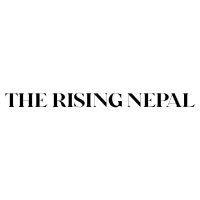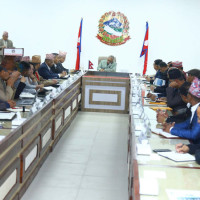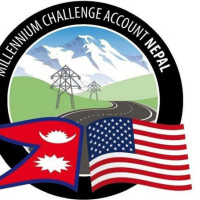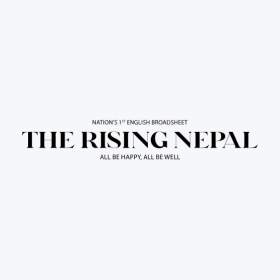- Tuesday, 23 December 2025
Resilience Of Nepal's Tourism Sector
Tourism is the economic and operational health of a country, measured by different indicators such as tourist arrivals, employment opportunities, revenue contribution, and viability of tourism businesses, according to the United Nations World Tourism Organisation (UNWTO). In Nepal, tourism contributes 6.7 per cent of GDP and supports 1.05 million jobs (WTTC, 2022). It also creates many jobs in other industries indirectly. The UNWTO estimates that one tourist will employ 12 people with direct and indirect contributions. Modern tourism in Nepal began in 1950 after it opened to foreign tourists.
It became a popular destination after the successful summit of Mt. Annapurna I (8,091m) by a French expedition led by Maurice Herzog and Louis Lachenal on June 3, 1950. It was the first 8,000-metre peak ever climbed by humans. Then, the successful ascent of Mt. Everest by Sir Edmund Hillary and Tenzing Norgay Sherpa on May 29, 2053, contributed to the steady growth of tourism in Nepal. However, it was rapidly hampered by the internal movement, including the 10-year-long Maoist insurgency (1996-2006) and frequent strikes. The 2015 earthquake and border blockade also crippled the sector. More recently, according to MoCTCA (2021), the COVID-19 pandemic had caused tourist arrivals to drop from 1.19 million in 2019 to just 230,085 in 2020.
Instability
Butler's (1980) Tourism Area Life Cycle (TACL) model explains how instability creates obstacles for the destination's growth. Dann's (1977) push-pull theory of tourism motivation cites political instability as a weakness factor in pulling tourists because of safety and accessibility concerns. Further, push-pull theory suggests fear, insecurity, and instability can deter travel, influencing demand. Leiper’s Tourism System (1990) explains how external factors hinder destinations. Ghimire (2014) argues that political movements, strikes, border blockades, and natural disasters will reduce tourist arrivals and revenue generation, leading to flight and booking cancellations. All the above theories and historical context indicate that the movement will directly affect the tourist demand.
According to tourism statistics for 2024, Nepal has received 1,147,548 tourists in 2024, an increase of 13.07 per cent from the previous year, which shows that Nepal tourism has just woken up from the COVID-19 pandemic. However, on September 8-9, the anti-corruption Gen Z movement happened in Nepal. It has dissolved the federal parliament, overthrown the government led by KP Sharma Oli, and formed a government led by Sushila Karki. This is just before the tourism season (September to November). Numerous tourism infrastructure have been destroyed by the protesters. Some of the five-star hotels were damaged. The globally recognised hotel chain Hilton was torched.
In this context, tour and trekking guide Uday Silwal shares that his guests had worried about his condition. They were requesting to come to their country for his safety. Furthermore, according to entrepreneur Uday Lamichhane, 45 guests have cancelled the booking for September, November, and December in his hotel, Amaryllis, which is equivalent to $15,000. Likewise, the founder of Tibet Boutique Hotel, Khagendra Regmi, says that more than 60 guests have cancelled the booking. Similarly, Regulus Nepal Treks and Expedition owner Madan Bhandari says about 200 tourists cancelled tour and trekking packages for September, October, and November, which is equivalent to $100,000, and he is not sure whether they will rebook or not. Khagendra shares that every tourism business is suffering.
According to Nepal Tourism Board CEO Deepak Raj Joshi, before this movement, tourist arrival was approximately 3200 per day, but after, it dropped to 1300. He said, "Some of the booked itineraries are cancelled, leading to lost business opportunities. We assume that negative news in international media about Nepal's destruction has made prospective tourists feel risky to visit Nepal, potentially reducing their numbers." And if such an incident continues again, it will hamper the whole season, he added.
But many of the booked tourists are having queries about the situation, and booking is not 100 per cent cancelled either. So if we could make sure everything is okay after 2 weeks, confidence will build again. So it seems that there will not be a huge impact for the season. Nepal is one of the quick-recovery destinations in the world. After the 2015 earthquake, there was also a 22-25 per cent growth in arrivals, and the private sector has built that resilience.
The Gen Z movement has negatively impacted the whole tourism industry through mass booking cancellations, which have reduced 60 per cent of tourist arrivals, and economic losses with significant employment crises. While the tourism sector is vulnerable, its long-term resilience is not predetermined. For the revival and sustainable growth of tourism, political stability is an absolute necessity. The government should provide support for tourism operators, and safety assurance for tourists is crucial.
Strategic marketing is essential for mitigating economic damage and quick recovery, as is the need for crisis management and policy interventions. In the long term, emphasis should be placed on strategies to minimise the losses and maintain tourist confidence for sustainable tourism development. Nepal is a quick-recovery destination; tourists are having queries about Nepal’s situation, and not all the booked itineraries have been cancelled. If we bring the trust to tourists that Nepal is safe to visit, confidence will be built again, and there will not be a huge impact for this season.
(The author is a lecturer at the Nepal Academy of Tourism and Hotel Management (NATHM))
















